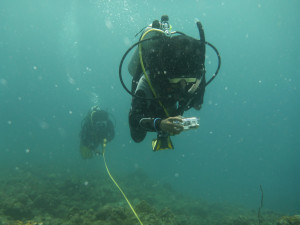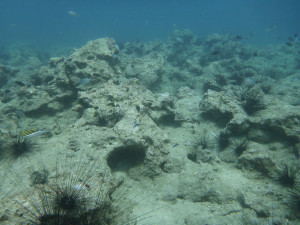
From dynamites to deadly storms: the Philippines’ vanishing underwater treasures
By: Roselle Eloise Bunayog
November 2, 2017
Four years after Yolanda’s deadly landfall, the survivors gradually surface from the super typhoon’s unimaginable wrath. Houses had been rebuilt and livelihood slowly restored. Within the coastal communities, the local fishermen ready their new gears as they make headway for an early catch. As the modest fisher folk haul in their nets, a hefty change was visible – fewer fishes are seized.
Dr. Jonathan Anticamara, a marine biologist and associate professor at the Institute of Biology in the University of the Philippines – Diliman has spent his career exploring the vast Philippine marine waters: surveying coral reefs, aquatic fauna and most significantly, heavily degraded sites. His keen pursuit to map the country’s coral reefs and fish distributions led him to complete a survey prior to and after the devastation wrought by the super typhoon.

Dr. Jonathan Anticamara surveying the coral reef damage and fish abundance in Leyte
Months after Yolanda, the coral reefs had been in severe distress. Their results show 30-70% loss of live coral cover in reef sites with pre- and post-Yolanda data. These sites include five barangays in Eastern Samar: Binabasalan, Kanigaran, Pearl Island, Bagumbanwa and Manapag. The survey undertakes the most comprehensive study yet of the region’s reefs spanning across six municipalities, starting in Lawaan to Balangiga, Giporlos, Quinapondan, Salcedo and Guiuan.
Results of the study, published in the journal Regional Environmental Change in 2016, indicates a ripple effect: declines in coral reef cover led to declines in fish numbers resulting in a meager catch and stunted fisher folk income.
“Most fishers already have struggles of catching fish before Yolanda,” he adds. “Their fish catch is usually around 2 kg. After Yolanda, that even got worse, some had 1 kg or less for 4 hours of fishing.”

Degraded reefs of Tanauan, Leyte
A deadly duo
The three-month study revealed an underlying culprit. Prior to the fatal storm, the coral reefs have long suffered from the blasting of dynamite and cyanide fishing. Significant chunks of dead coral colonies or extensive piles of recently broken coral branches serve as proof to this environmental crime.
“Corals as large as our heads are about 40 years old,” Anticamara explains. Ranging from 3-6 meters of width, its estimated age can reach a whopping 20,000 even 50,000 years old – roughly the period when woolly mammoths were hunted to extinction.
Commonly mistaken as rocks, coral reefs are formed by corals which are in fact, tiny animals. Its symbiotic relationship with algae (called zooxanthellae) enables it to produce food on its own. Corals typically hide during the day— masking the sway of the tiny animals, further unveiling its bicarbonate (rocky) built.
“Everywhere you go in the Philippines, even in the fishing villages, if you ask the kids what are corals, they will say it is a piece of rock. They’re not rocks, but tiny animals”, he had to explain to many kids.
“People don’t understand that big corals are very, very old animals, and it took them a long time to get to that size,” he says. “So when they blast it with a dynamite, they don’t realize that corals take many years to form and recover into a healthy, diverse and productive reef system.”
In underprivileged communities, fish bombings have been prevalently used by the fisher folk to rapidly gain a substantial catch. Then Yolanda came. The super typhoon’s violent slam resembled fuel added to fire. Its extreme impact completely aggravated the corals’ vulnerable condition. Together—underwater explosions and super typhoons form a lethal combination.
On a positive note, coral reefs that appear like bedsheets (encrusting coral forms) seemed to have outsmarted the deadly duo as the study shows. Its flat and thin sheet figure allows it to creep onto the seabed or sturdy substrates, making it difficult for strong winds and currents to wreak havoc on its actually fragile body.
Despite collaborative efforts that push for coral reef recovery, the future looks bleak. A 2015 study2 published in Science Advances predicts that by 2100, typhoons can be progressively fiercer by an additional 14% — the key ingredient: overheated oceans and acidification brought about by increasing greenhouse gas emissions mainly from cars and industries. Especially if greenhouse gas emissions are not reduced, the advent of super typhoons will be the “new normal.” If destructive fishing continues, the killer duo could inevitably drive Earth’s most diverse terrain to its untimely demise.

Piles of fish killed via dynamite fishing in Tanauan, Leyte
“In general, the fish will recover – big fish will come back. But corals, even if you protect them, if the entire area is full of rubble, there’s no way for baby coral to settle,” Anticamara says, adding that when corals attach to rubble, strong currents might topple it, leaving a still-barren ecosystem in 10-15 years, in the absence of effective and active coral restoration strategies.
The road to recovery
To address these issues, the UP marine biologist hopes for a stern alignment of environmental policies. “There must be a serious discussion if (we) the Filipinos have to survive,” he says. The teeming, underwater jungle brings life to the coastal communities. It is home to myriad of marine organisms, which is a source of food and income to nearby and distant residents.
About 70-80% of the coastal Samar-Leyte population is heavily reliant on the coral reefs and its collapse will have negative effects on food security, biodiversity, and local economy.
One misguided response of the government is to give more fishing gears and boats to the fishers, the author explains. Donation of more fishing equipment is less effective since fewer fishes will still be caught in view of habitat loss after the typhoon.
“People tend to ignore (the state of our natural resources), because they only see the extractive value, just the money, but they fail to realize that in degraded areas, more extraction will not yield more income,” he adds. “Thus, we need to help people develop multiple values (e.g., non-extractive values such as tourism or production of profitable arts, crafts, and innovations that are inspired by nature) in order for our biodiversity to recover and provide sustained benefits to Filipino societies with the future generations in mind.”
The government might pay attention to the recovery of coral reefs only when it is too late. But Anticamara hopes that anticipative management will be pushed ultimately by the public officials. A Plan B or C on livelihood and food production must be considered in order to sustain the lives of 100-200 million Filipinos in the years to come.
One step, as Anticamara believes, is to use science as a tool to manage and recover resources. “I want to show to the Filipinos what’s going on underwater – why there’s a lot of degradation and at least clarify what are the options,” he adds.
Furthermore, he stresses that people should consume mature fishes, in lieu of seizing small ones that have not yet reproduced. By taking small steps towards climate change – conserve energy, and have less gas emissions and wastes– “we contribute something to the needed change,” he says.
In hindsight, the post-Yolanda study serves as a crucial eye-opener. It tells of a neglected story of a national treasure amidst a fast-changing environment and a rapidly growing Filipino population that is mostly somewhat still trapped in the cycle of poverty, over-exploitation, and resource degradation, and are in great need of alternative pathways to sustainable development. Perhaps now, the nation will realize that it needs to foster innovative ways to resurrect dead coral reefs and degraded marine biodiversity in order to sustain Filipinos into the future.
References
- Anticamara, J. A. and Go, K.B. 2016. Impacts of super-typhoon Yolanda on Philippines reefs and communities. Regional Environmental Change 17:703-713.
- Mei, W. et al. 2015. Northwestern Pacific typhoon intensity controlled by changes in ocean temperatures. Science Advances 1 4.
This article was written by Ms. Roselle Eloise Bunayog, a BS Biology graduate of UP Manila, and edited by Dr. Lillian Jennifer Rodriguez, a faculty member of the UP Institute of Biology.
